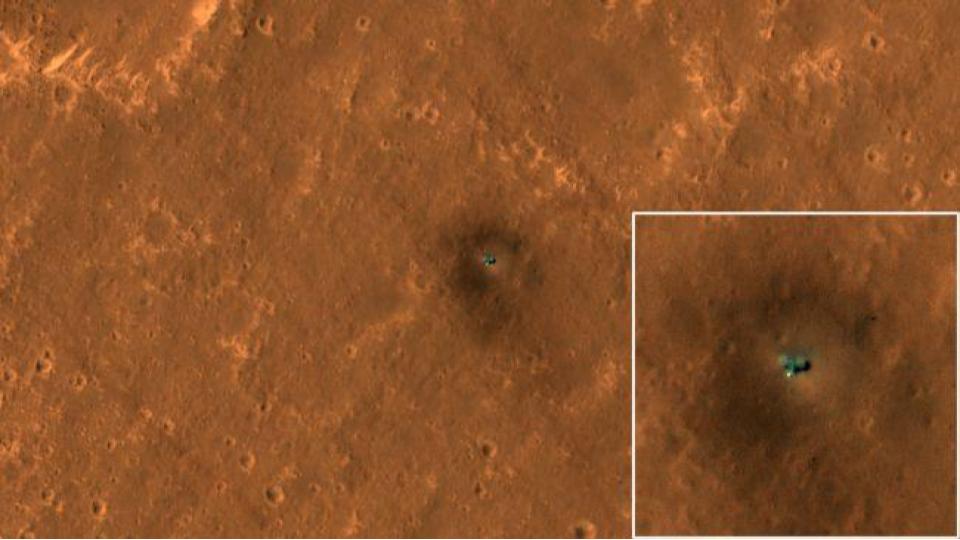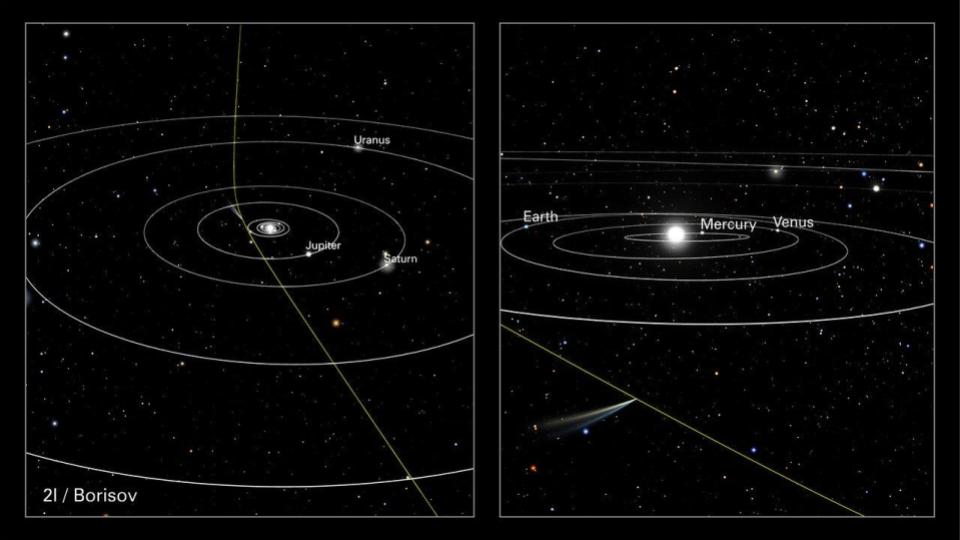Sometimes a podcast is a particularly weird way to communicate astronomy, a fundamentally image driven science. In this episode we describe new images of the Insight and Curiosity missions on Mars , of Comet 2I/Borisov, splotches of organics on Titan, and super spiral galaxies.
Transcript
This is the Daily Space for today, Thursday, October 17, 2019. I am your host, Dr Pamela Gay, and I am here to put science in your brain.
———————

- HiRISE Views NASA’s InSight and Curiosity on Mars (News Release)
Today’s first story is a quick photo piece. The Mars Reconnaissance Orbiter’s HiRISE camera has been studying the Elysium Planitia, a large plain in Mars equatorial region that is currently home to the InSight Mission. While HiRISE’s primary goal was to look for changes in the region due to effects like dust devils, it also happened to catch a sharp image of this lander and its surrounding blast zone. InSight landed using descent engines, and these stirred up the dust and debris in the region around where InSight landed, revealing an ellipse of darker material. In the HiRISE image – which you can view on our website, dailyspace.org – it’s possible to make out InSight’s two large circular solar panels as well as the shiny cover to it’s seismograph.
These kinds of images provide a context to the scientific measurements the rovers and landers are making on the ground. This can be particularly important for the rovers, where they not only give a scientific context, but also provide a navigational assist. In a new animated gif released by JPL, which you can also see on our website, HiRISE tracks Curiosity’s progress through Gale Crater as it climbs toward mount sharp. Gale Crater is filled with sand dunes and other hazards, and with the HiRISE images it’s possible to see how the Mars Rover Driver Team have had to optimize their track for both safety and science.
While there isn’t anything particularly scientific about seeing these images, they were still released via a press release feed, showing that sometimes all it takes is the right pretty pictures to define the news cycle.

- Hubble Observes New Interstellar Visitor (Press Release)
Today’s news is largely made up of pretty pictures, and in our second story we have an animation of Hubble Space Telescope images of comet 2I/Borisov. Seen at a distance of 260 million miles, Borisov continues to look absolutely average.
Comet Borisov is approaching our inner solar system from below the ecliptic or the disk of the planets. When it is closest to the Sun on December 7, it will be near Mars and almost opposite from the Earth around the Sun. While this geometry is frustrating, the nearly vertical motion of the object through our solar system means it will never be hidden by the Sun for long.
Since this is our first extrasolar object spotted on its way into the Solar System, I suspect we will be getting near daily updates on it’s so far ordinary existence.
Our next story is one that I first read on space.com. In a piece titled “A Faux Moon Titan on Earth Could Solve Solar System Mystery.”
In newly published research, scientists from the University of Hawaii at Manoa describe laboratory experiments they performed to try and understand how complex organic molecules can form on cold icy worlds like Titan. In this experiment, they took a block of ice made from acetylene and exposed it 100 years worth of simulated cosmic rays. Acetylene is a triply bonded C2H2 molecule, and with the added cosmic energy, it was able to transform into the significantly more complex polycyclic hydrocarbons observed on Titan and other icy worlds. This work is just a starting point, and more research is needed to understand exactly what kinds of cosmic rays are needed, and to identify what may or may not change when the energy is delivered over a 100 years, rather than under the sped up lab conditions. Still, this is a cool start to understanding a new area of chemistry.

- Mosaic of Super Spirals (News Release)
In our final story of the day, we take a look at a new class of galaxy, the super spiral. It had previously been thought that while Elliptical galaxies come in ever larger and larger sizes, systems with spiral arms had a narrower range of sizes. In new research released in the Astrophysical Journal Letters, researchers lead by Patrick Ogle announce that they have identified 100 super spirals using the Sloan Digital Sky Survey, and from observations with the Southern African Large Telescope, they have determined these systems are nested inside massive dark matter halos that cause them to rotate at breakneck speeds. Unlike similarly sized elliptical systems, these spirals are still forming stars, although they have an overall lower number of stars than might be expected for this size of a system. According to the press release, “[t]his suggests that the sheer amount of dark matter inhibits star formation. There are two possible causes: 1) Any additional gas that is pulled into the galaxy crashes together and heats up, preventing it from cooling down and forming stars, or 2) The fast spin of the galaxy makes it harder for gas clouds to collapse against the influence of centrifugal force.”
The unusual light to mass ratio of these systems provides us one more line of evidence that dark matter is a stuff rather than a misunderstanding of gravity. If it was just a misunderstanding of gravity, we’d expect this system to follow the same rotation rules we see in lower mass systems. Since it doesn’t, we can instead say this system contains an unusual amount of dark matter, and accept gravity as it is.
———————
And that rounds out our show for today.
Thank you all for listening. The Daily Space is produced by Susie Murph, and is a product of the Planetary Science Institute, a 501(c)3 non profit dedicated to exploring our Solar System and beyond. We are made possible through the generous contributions of people like you. If you would like to learn more, please check us out on patreon.com/cosmoquestx
Each live episode of the Daily Space is archived on YouTube. If you miss an episode here on Twitch.tv, you can find it later on youtube.com/c/cosmoquest. These episodes are edited and produced by Susie Murph.
We are here thanks to the generous contributions of people like you who allow us to pay our staff a living wage. Every bit, every sub, and every dollar committed on Patreon.com/cosmoquestx really helps. If you can’t give financially, we really do understand, and there are other ways you can help our programs. Right now, the best way you can help is to get the word out. Let your friends know, share our channel on your social media, or leave a recommendation. You never know what doors you are opening.
We really wouldn’t be here without you – thank you for all that you do.


 We record most shows live, on Twitch. Follow us today to get alerts when we go live.
We record most shows live, on Twitch. Follow us today to get alerts when we go live.